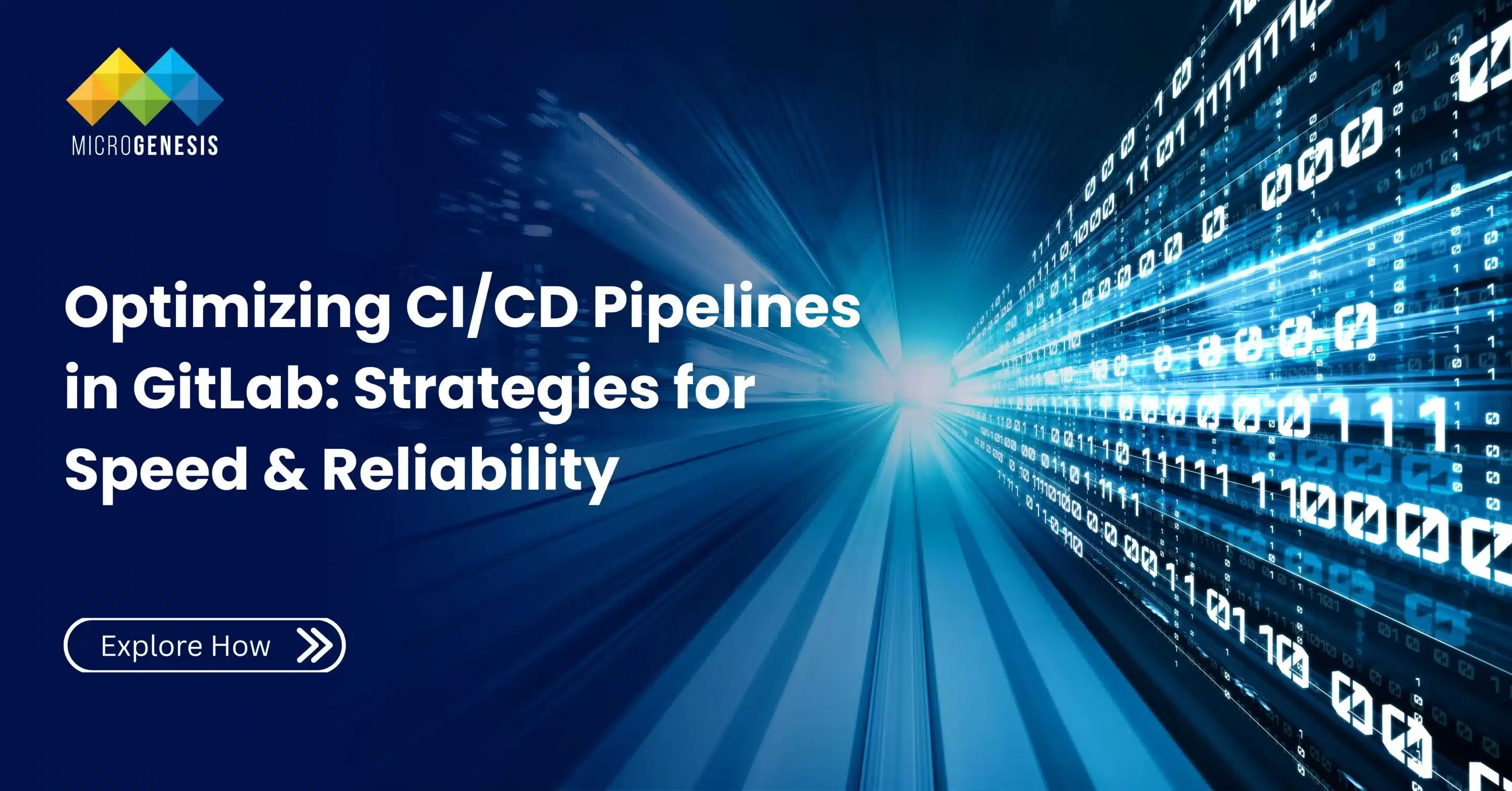Continuous Integration and Continuous Deployment (CI/CD) are the backbone of modern software delivery.
GitLab’s integrated DevOps platform makes it possible to automate, monitor, and improve every step — from code commit to production release — in one unified system.
But as teams grow and pipelines become more complex, maintaining speed, reliability, and scalability can be challenging. This guide explores how to design, optimize, and manage GitLab CI/CD pipelines that deliver consistently fast, secure, and high-quality results.
1. Understanding CI/CD in GitLab
GitLab CI/CD enables developers to automate testing, integration, and deployment.
Each change in the code repository can trigger a pipeline — a sequence of stages and jobs defined in a YAML file (.gitlab-ci.yml).
Key Concepts:
- Pipeline: The full sequence of automated stages.
- Stage: Logical phase (e.g., build → test → deploy).
- Job: A specific task, such as compiling code or running tests.
- Runner: An agent that executes jobs on specific environments.
This modular design allows teams to build flexible pipelines that fit any project — from small open-source applications to enterprise-scale microservices architectures.
2. Designing an Efficient Pipeline Architecture
An optimized pipeline structure balances speed and reliability. Poorly designed pipelines can cause delays, resource waste, and false test results.
2.1 Modular Pipeline Stages
Keep stages minimal and goal-oriented. A common structure includes:
- Build – Compile code, build containers or binaries.
- Test – Run automated unit, integration, and security tests.
- Package – Create artifacts or Docker images.
- Deploy – Push to staging or production environments.
Each stage should run in parallel where possible, using GitLab’s parallel job execution to reduce total runtime.
2.2 Use Caching and Artifacts
- Caching stores dependencies and speeds up repetitive tasks (e.g., npm, Maven).
- Artifacts persist build outputs between stages (e.g., compiled binaries or test reports).
This minimizes redundant work and keeps pipelines lightweight.
2.3 Conditional Pipelines
Use rules: and only/except: to control when jobs run.
Example: Skip deployments on feature branches, or run tests only when specific files change.
This ensures resources are used efficiently.
3. Speed Optimization Techniques
Pipeline speed is often a reflection of smart architecture and efficient resource use.
Below are strategies to make your GitLab pipelines faster without compromising quality.
3.1 Run Jobs in Parallel
Split long-running test suites into smaller jobs using matrix builds or parallelization.
Example: Run frontend and backend tests simultaneously.
3.2 Use Docker-in-Docker (DinD) Wisely
Docker builds are powerful but resource-intensive. Use lightweight base images (like Alpine) and prebuilt containers to speed up execution.
3.3 Optimize Runners
- Deploy multiple runners (shared or specific).
- Assign runners based on job type — CPU, memory, or GPU heavy.
- Use autoscaling runners on cloud platforms to handle workload spikes.
3.4 Cache Intelligently
Cache dependencies per branch or version tag to avoid redundant downloads.
Use unique cache keys to prevent conflicts between different projects.
3.5 Avoid Unnecessary Steps
Review pipeline YAMLs regularly — remove redundant tests, outdated scripts, or unused build artifacts.
4. Improving Reliability and Consistency
Fast pipelines are good, but reliable pipelines are better.
A stable CI/CD process ensures every deployment behaves consistently across environments.
4.1 Use Versioned Dependencies
Pin package versions in configuration files. This avoids “works on my machine” issues and inconsistent builds.
4.2 Apply Quality Gates
Set mandatory conditions before deployment:
- Tests must pass with 100% success.
- Security scans must report no critical vulnerabilities.
- Merge approvals required before production rollout.
4.3 Implement Canary Deployments
Use GitLab’s Auto DevOps or custom scripts for canary releases — deploy to a small subset of users first, validate performance, then expand gradually. With guidance from experienced DevOps consultants, organizations can implement these strategies effectively, reduce deployment risks, and ensure smooth, reliable releases.
4.4 Rollback Mechanisms
Always prepare rollback scripts or snapshot-based deployments.
GitLab CI/CD supports versioned artifacts, allowing instant reversion if an issue occurs.
5. Leveraging Automation for End-to-End Efficiency
Automation is the true strength of GitLab CI/CD. Every repetitive action can be turned into an automated rule.
5.1 Automated Testing
Include unit, integration, and UI tests in every pipeline.
Use frameworks like JUnit, pytest, or Cypress with GitLab test reports for complete visibility.
5.2 Security Automation (DevSecOps)
Integrate security checks early:
- SAST for static code analysis
- DAST for runtime vulnerability detection
- Dependency Scanning for open-source libraries
Automated reports appear directly in merge requests, promoting secure coding habits.
5.3 Continuous Deployment Automation
Define environment-specific deployment jobs:
- Staging for QA validation
- Production for approved releases
Use GitLab environments and review apps for temporary test deployments — ideal for agile sprints.
6. Monitoring, Reporting, and Troubleshooting
An optimized pipeline includes visibility at every step.
6.1 Use Built-in Monitoring
GitLab’s pipeline dashboards display:
- Job duration trends
- Failure rates
- Resource utilization
- Recent deployment history
Use this data to pinpoint bottlenecks and continuously improve performance.
6.2 Integrate Prometheus and Grafana
For enterprise setups, integrate Prometheus and Grafana for real-time metrics on pipeline execution, runner usage, and system load.
6.3 Improve Error Reporting
Define custom failure messages and log artifacts.
Use job retry policies and timeout limits to automatically handle transient issues.
7. Real-World Optimization Example
Scenario:
A global e-commerce company was facing slow pipeline execution — builds took 45 minutes, with frequent timeouts.
Solution:
- Split test suites into five parallel jobs.
- Introduced caching for dependencies.
- Migrated runners to autoscaling Kubernetes clusters.
- Automated environment cleanup post-deployment.
Result:
Pipeline time reduced to 12 minutes. Deployment frequency doubled, and MTTR dropped by 40%.
This illustrates how a few structured optimizations can have massive operational impact.
8. Governance and Compliance in Pipelines
As organizations scale their DevOps practices, maintaining governance and regulatory compliance becomes critical. GitLab provides several built-in mechanisms that enforce policies, control access, and ensure traceability throughout the CI/CD lifecycle. These features reduce risk, maintain accountability, and support audit readiness without slowing down development.
Read more: Jira Resource Planning: How to Maximize Your Investment with the Right Team and Partner
1. Role-Based Access Control (RBAC)
GitLab allows administrators to define granular permissions for different roles, such as developers, maintainers, or auditors. Teams can control who can trigger pipelines, approve jobs, or modify configurations. This minimizes unauthorized changes, ensures sensitive operations are restricted, and maintains a clear chain of responsibility across the organization.
2. Approval Rules
Approval rules enable teams to enforce mandatory reviews before critical deployments, such as production releases. You can specify the number of required approvers, assign approval by role or team, and even enforce multiple-stage approvals. This ensures that all changes are thoroughly validated, reducing the risk of errors and maintaining accountability. With expert DevOps services, organizations can implement these approval workflows efficiently, streamline governance, and enhance deployment reliability.
3. Audit Logs
GitLab automatically logs all pipeline activities, including job executions, configuration changes, and merge requests. These audit logs provide a detailed record of who did what and when, making it easier to investigate incidents, meet compliance standards, and support regulatory audits. This transparency strengthens internal controls and organizational trust.
4. Policy-as-Code
GitLab supports policy-as-code, allowing organizations to encode security, compliance, and workflow rules directly into pipeline definitions. For example, teams can enforce automated security scans, code quality checks, or mandatory testing for every merge request. By codifying governance, organizations reduce manual oversight and ensure consistent enforcement across all projects.
9. Future Trends: The Rise of AI and Predictive Pipelines
GitLab is investing heavily in AI-driven DevOps.
Features like GitLab Duo are designed to suggest code, detect anomalies, and auto-optimize pipelines.
Future CI/CD pipelines will:
- Predict bottlenecks based on historical runs.
- Recommend pipeline optimizations automatically.
- Detect flaky tests and retry intelligently.
- Use ML-driven security scanning to detect complex threats.
This marks a shift from reactive automation to intelligent orchestration.
10. Key Takeaways for Teams
| Area | Strategy | Benefit |
| Pipeline Design | Modular stages, caching, conditional jobs | Faster execution |
| Reliability | Versioned dependencies, canary releases | Stable deployments |
| Automation | CI/CD, testing, DevSecOps | Fewer manual tasks |
| Monitoring | Dashboards, logs, metrics | Continuous improvement |
| Governance | RBAC, approvals, audit logs | Secure and compliant pipelines |
By following these principles, teams can transform GitLab from a simple CI/CD engine into a high-performance DevOps backbone — enabling faster releases, stronger collaboration, and long-term reliability.
Conclusion
Optimizing CI/CD in GitLab isn’t just about faster builds — it’s about building smarter systems that evolve with your business. By combining automation, monitoring, and governance, teams can reduce lead times, increase quality, and gain confidence in every deployment. With MicroGenesis DevOps consulting services, organizations can implement best practices, streamline pipelines, and achieve reliable, high-performing software delivery.
As GitLab continues to evolve with AI and cloud-native capabilities, mastering pipeline optimization will remain a key skill for every DevOps-driven organization. Partnering with a top software company like MicroGenesis ensures expert guidance, streamlined pipelines, and reliable, high-performance software delivery.




